
Ranunculaceae is a family of over 2,000 known species of flowering plants in 43 genera, distributed worldwide.

Thalictrum is a genus of 120-200 species of herbaceous perennial flowering plants in the buttercup family, Ranunculaceae, native mostly to temperate regions. Meadow-rue is a common name for plants in this genus.

Freyer's pug is a moth of the family Geometridae. The species can be found in Europe, east to the Urals, the Russian Far East, Kazakhstan and China. It is also found in North America.
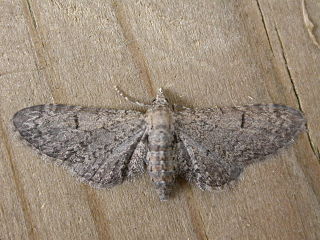
Eupithecia ultimaria, the Channel Islands pug, is a moth of the family Geometridae. The species was first described by Jean Baptiste Boisduval in 1840. It can be found in Europe, where it is found in Portugal and Spain, coastal western and southern France, Italy, the Mediterranean islands including Cyprus and Greece. It is also found in southern England and the Channel Islands. Furthermore, it is present in North Africa, Lebanon, Israel, Iraq and Iran.
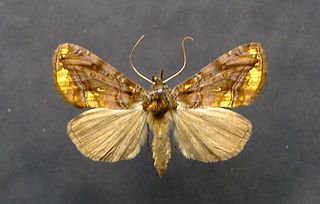
Lamprotes c-aureum is a moth of the family Noctuidae. It is found from Southern Scandinavia to the Southern Alps and from Western Europe up to West Siberia.

Euchalcia variabilis, the purple-shaded gem, is a moth of the family Noctuidae.

Scopula rubiginata, the tawny wave, is a moth of the family Geometridae. The species was first described by Johann Siegfried Hufnagel in 1767.

Thalictrum flavum, known by the common names common meadow-rue, poor man's rhubarb, and yellow meadow-rue, is a flowering plant species in the family Ranunculaceae. It is a native to Caucasus and Russia (Siberia). Growing to 100 cm (39 in) tall by 45 cm (18 in) broad, it is an herbaceous perennial producing clusters of fluffy yellow fragrant flowers in summer.

Thalictrum fendleri is a species of flowering plant in the buttercup family known by the common name Fendler's meadow-rue. It is named in honor of Augustus Fendler.

Eupithecia actaeata is a Eurasian species of moth of the family Geometridae.

Eupithecia distinctaria, the thyme pug, is a moth of the family Geometridae. It is found throughout Europe. It is also found in Iran. from the Iberian Peninsula through western and central Europe including the British Isles as well as further east as far east as far as Russia and Iran. In the north the range reaches as far as the southern Fennoscandia, to the south, where it is more common, it occupies the Mediterranean and Asia Minor. It is found primarily on warm, stony slopes and rocky structures as well as on sparse grassy areas with thyme mounds. In the Alps, it rises to heights of 2000 metres.

Eupithecia silenicolata is a moth in the family Geometridae. It is found from southern Europe and Morocco to western Asia, Iran and Pakistan. In the north, the range extends to southern Switzerland, Austria and northern Italy.
Eupithecia carpophagata is a moth in the family Geometridae. It is found in the mountains of Europe, including the eastern Pyrenees, the central and southern part of the Alps, the Massif Central, the central Apennines and the Balkan Peninsula.
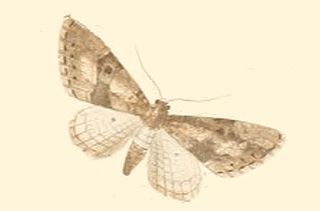
Eupithecia gueneata is a moth in the family Geometridae. It is found in most of southern and eastern Europe, as well as the Near East and North Africa.
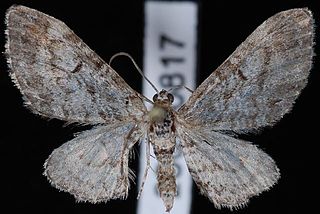
Eupithecia graefi, or Graef's pug, is a moth in the family Geometridae. The species was first described by George Duryea Hulst in 1896. It is found in North America from south-western Alberta west to Vancouver Island, north to Alaska and south to California. The habitat consists of wooded areas.
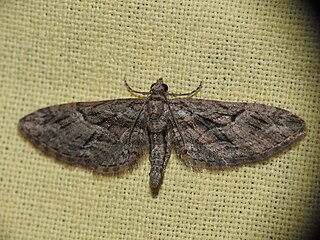
Eupithecia oxycedrata is a species of moth in the family Geometridae. It is found in Spain, southern Portugal, the Balearic Islands, southern France, Corsica, Sardinia, Sicily, Malta, Italy, Slovenia, Croatia, Bosnia and Herzegovina, Montenegro, North Macedonia, Bulgaria, Greece, Crete, western Romania and the Crimea. It is also found in North Africa, from Morocco to Tunisia, and in Turkey. The habitat consists of dry maquis, especially where junipers grow.

Eupithecia misturata is a moth in the family Geometridae first described by George Duryea Hulst in 1896. It is widely distributed in western North America.
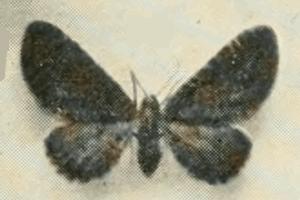
Eupithecia thalictrata is a moth in the family Geometridae. It is found from Europe to the eastern Palearctic realm.

Panchrysia aurea is a moth of the family Noctuidae. It is found in southern Europe and western and central Asia. The range extends from Portugal, east to Tian Shan, the Altai and the north-western Himalayas. In central Europe, it is found in the southern Alps, lower Austria and the mountains on the Balkan Peninsula.

Plusidia cheiranthi is a moth of the family Noctuidae. It is found in Southern and Eastern Europe, in Turkey, Siberia and eastwards to the Pacific Ocean.

















